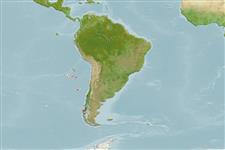>
Acropomatiformes (Oceanic basses) >
Epigonidae (Deepwater cardinalfishes)
Etymology: Epigonus: Greek, epi = over, in front + Greek, gonio = angle (Ref. 45335).
Environment: milieu / climate zone / depth range / distribution range
Ecologia
marinhas batidemersal; intervalo de profundidade 230 - 340 m (Ref. 31632). Deep-water
Southeast Pacific: seamount in the Nazca chain. High Seas only.
Tamanho / Peso / Idade
Maturity: Lm ? range ? - ? cm
Max length : 23.8 cm SL macho/indeterminado; (Ref. 31632)
Descrição breve
Chaves de identificação | Morfologia | Morfometria
No opercular spines. 8 spines on first dorsal fin. No teeth on tongue. Last spine of the first dorsal fin is considerably removed from the next to last spine and is not joined to it by a membrane (Ref. 31632).
A mesobenthic-pelagic species living mainly above the bottom (Ref. 31632). No length type given but assumed to be SL.
Life cycle and mating behavior
Maturidade | Reprodução | Desova | Ovos | Fecundidade | Larvas
Abramov, A.A., 1992. Species composition and distribution of Epigonus (Epigonidae) in the world ocean. J. Ichthyol. 32(5):94-108. (Ref. 31632)
Categoria na Lista Vermelha da IUCN (Ref. 130435: Version 2024-1)
Ameaça para o homem
Harmless
Utilização humana
Ferramentas
Relatórios especiais
Descarregue XML
Fontes da internet
Estimates based on models
Preferred temperature (Ref.
123201): 4.4 - 13.3, mean 10.6 °C (based on 40 cells).
Phylogenetic diversity index (Ref.
82804): PD
50 = 0.5000 [Uniqueness, from 0.5 = low to 2.0 = high].
Bayesian length-weight: a=0.00646 (0.00275 - 0.01515), b=3.10 (2.89 - 3.31), in cm total length, based on LWR estimates for this (Sub)family-body shape (Ref.
93245).
Nível Trófico (Ref.
69278): 3.6 ±0.5 se; based on size and trophs of closest relatives
Resiliência (Ref.
120179): Médio, tempo mínimo de duplicação da população 1,4 - 4,4 anos (Assuming tm=2-4).
Fishing Vulnerability (Ref.
59153): Low vulnerability (19 of 100).
